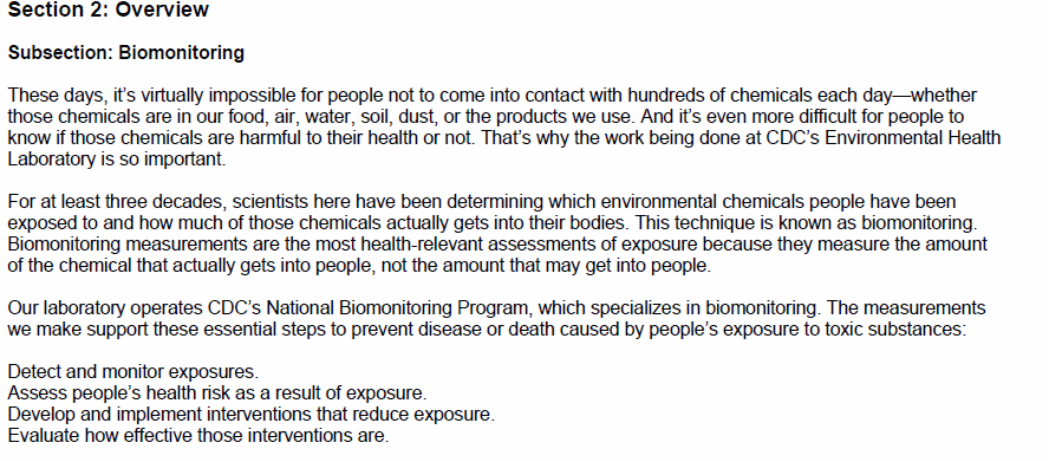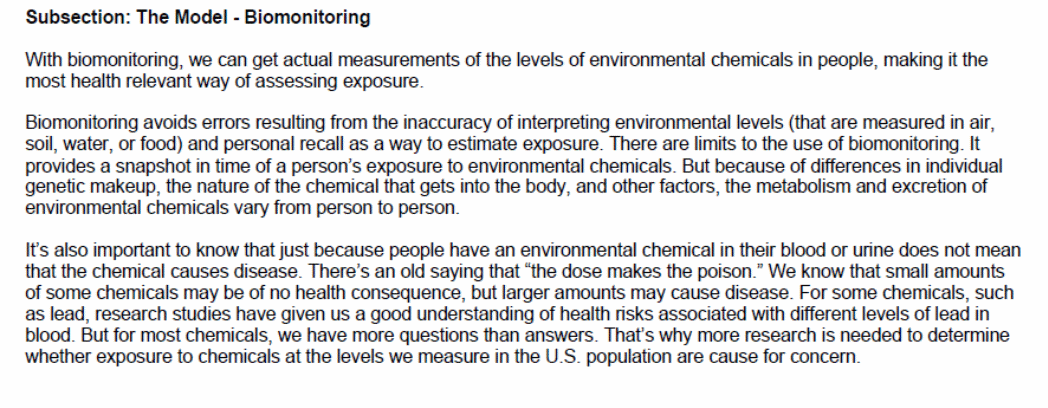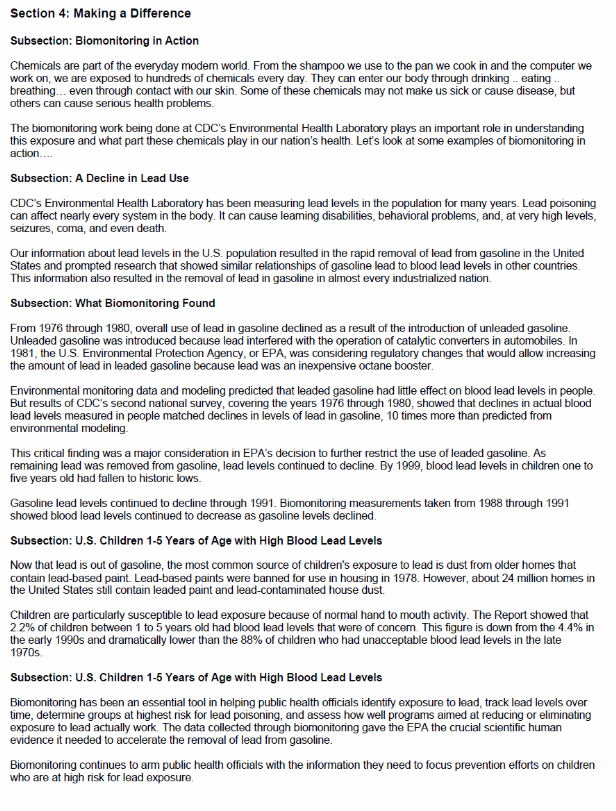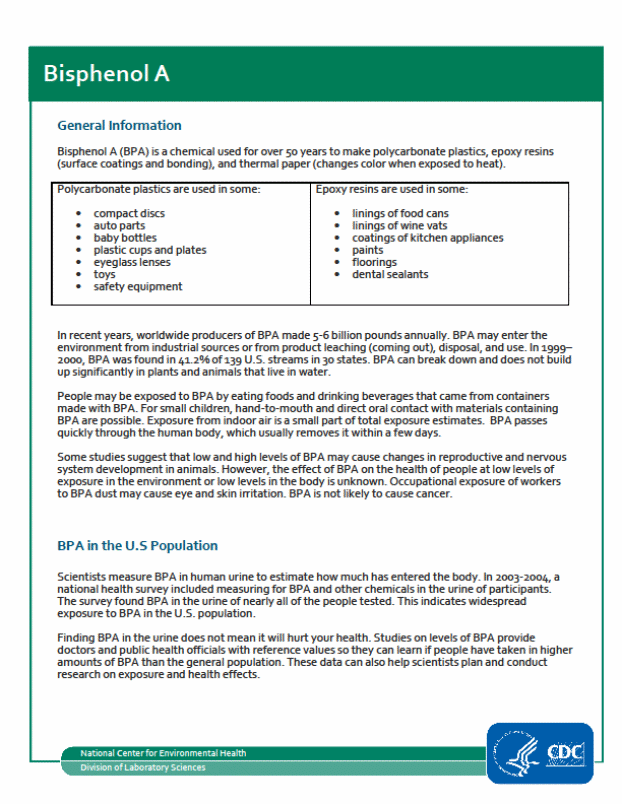Form Attachment 4 Attachment 4 Exploratory Focus Group with Women Selected
Audience Analysis for Biomonitoring
Attachment 4_Exploratory Focus Group Discussion Guide_FINAL.DOCX
Exploratory Focus Group with Selected Women
OMB: 0920-0878
Exploratory Focus Group Discussion Guide
Selected Women
PURPOSE STATEMENT: To explore perceptions of and responses to scientific uncertainty in order to inform a framework for communications about CDC’s biomonitoring research.
Introduction (10 minutes)
THANK RESPONDENTS FOR ATTENDING. BRIEFLY INTRODUCE SELF.
GROUND RULES
CONFIDENTIALITY
HONESTY/OK TO DISAGREE
TAPING
SPEAKING ONE AT A TIME
BATHROOM
ETC
[GO AROUND THE ROOM, ASK RESPONDENTS INTRODUCE THEMSELVES.] Can you please give me your first name and tell me the names and ages of your children.
Attitudes Toward Health and Scientific Uncertainty (15 minutes)
Let’s start with talking about science and health. New scientific discoveries related to health come out all the time.
What are some ways that science contributes to improving health in our society? [PROBE: health research?]
With a show of hands, how interested are you in stories about health research? [very interested, somewhat interested, not really interested]
Those of you that said you were interested, what are some reasons that make you interested?
Those of you that aren’t interested, what are some reasons for that?
Where do you hear about health research?
When you hear new health information or research results, how do you know that it’s believable?
[EXAMPLES IF NECESSARY: who you heard it from, who conducted it, how many times you hear it]
[PROBE: trusted sources?]
In general, what makes “good science”? What qualities does it have? [CLARIFY IF NECESSARY: what makes good health research?]
[EXAMPLES IF NECESSARY: source, reliability, replicability, unbiased]
Who conducts “good science”? [CLARIFY IF NECESSARY: who conducts good health research?]
Does the government do “good science”? [CLARIFY IF NECESSARY: what about good health research?]
What are some of the limitations of “good science”? [CLARIFY IF NECESSARY: are they the same limitations for good health research?]
[EXAMPLES IF NECESSARY: cost, takes too long, inconclusive results, conflicting information]
Communication about Uncertainty (15 minutes)
[EXERCISE 1] [ON EASEL, WRITE WORD “UNCERTAINTY”] Many of the examples that you just gave about the limitations can be summed up in this word, uncertainty. Let’s take a minute to explore what scientific uncertainty means to you.
What do think scientific uncertainty is? [WRITE DOWN EXAMPLES ON EASEL]
Good science takes time and uncertainty can be part of the process. Is uncertainty inherent in good science?
What does that imply? (Is it a good thing? A bad thing?)]
Can you think of any examples of health information or research results that had some uncertainty?
Is it important for the average person to hear about ways in which science is uncertain? Tell me about that.
Thinking about what you currently hear about scientific uncertainty related to health research studies, do you want to hear more, less, or are you getting the right amount?
Information about health is sometimes uncertain. In other words, sometimes there isn’t enough information for us to draw conclusions about “what to do”. Even if the information isn’t always clear, does information about potential health risk affect the decisions you make for yourself or your family? How?
What do you do?
What factors help you decide whether to do something or not? [PROBE: who the information comes from? How you found out about it? Hearing about it from more than one place?]
What happens when you hear conflicting information from different sources? [PROBE: How do you know who or what to believe?]
About biomonitoring (10 minutes)
We’ve been talking a lot about uncertainty. One area with a lot of uncertainty is research on how chemicals in the environment affect our health.
What have you heard about this? (How chemicals in the environment affect our health?)
One way scientists find out more about the impact of chemicals on people’s health is through a process called biomonitoring. This video describes a little bit more about biomonitoring and who conducts it. Please watch and we’ll talk about it after.
[PLAY VIDEO SEGMENTS] http://www.cdc.gov/biomonitoring/flash/presentation_popup.html
OVERVIEW – SUBSECTION 1: BIOMONITORING
OVERVIEW – SUBSECTION 6: THE MODEL-BIOMONITORING
What is biomonitoring?
Who is doing this biomonitoring?
What is the purpose of biomonitoring? What does it tell us?
What are some ways biomonitoring is uncertain? What does it not tell us?
UNCERTAINTY EXAMPLE (LEAD) (10 MINUTES)
Let’s keep watching the video. Here is an example of how biomonitoring can impact public health.
[PLAY VIDEO] http://www.cdc.gov/biomonitoring/flash/presentation_popup.html
MAKING A DIFFERENCE – SUBSECTIONS 1—5 (ABOUT LEAD)
So this is an example of how biomonitoring measured exposure to lead and was able to confirm that removing lead from gasoline reduced the public’s exposure to lead. However, it took 20 years and a lot of careful research. The results that showed dramatic decreases in blood lead levels following the removal of lead from gasoline removed a lot of uncertainty about how the public was exposed to this chemical.
But there are new chemicals coming onto the scene all the time. Now let’s talk about a chemical that has been in the news a lot lately, bisphenol A, or BPA.
What have you heard about BPA?
UNCERTAINTY EXAMPLE (BPA) (20 MINUTES)
Here is something CDC is developing about BPA. Keep in mind that this document is a bit technical is in its very beginning stages. Please read though and underline things that talk about uncertainty related to the impacts of BPA on our health.
READ CDC HANDOUT ON BPA – UNDERLINE WORDS THAT TALK ABOUT UNCERTAIN SCIENCE
What did you underline?
When you see information that includes uncertainty like this, what do you think about the research?
Do you think scientists draw different conclusions about the health effects of BPA?
Do you think the information provided here is the best available at present?
Do you think it possible for scientists to have all the answers about BPA?
Does more scientific work need to be done on the topic?
What is your impression of the CDC? [PROBE ON TRUST]
Do you think they are withholding information from the public?
Is the CDC unsure about the amount of BPA the public is exposed to?
How do you think CDC feels about the safety of BPA?
Do you think the CDC lacks definite knowledge about how BPA affects our health?
After having read this, is there any additional information you’d like?
FINAL EXERCISE [5 minutes]
Based on what you’ve seen here from CDC, write a postcard to a loved one that tells them something they should know about BPA.
THANK YOU!!!!
APPENDIX A. Selected Transcript Sections- Biomonitoring: Making a Difference




APPENDIX B. CDC’s Working BPA Factsheet

| File Type | application/vnd.openxmlformats-officedocument.wordprocessingml.document |
| Author | Jennifer Berktold |
| File Modified | 0000-00-00 |
| File Created | 2021-02-01 |
© 2026 OMB.report | Privacy Policy